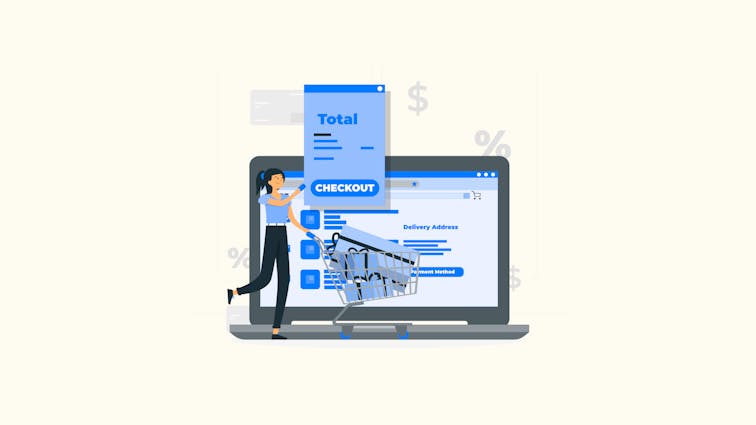
E-commerce Functionality Checklist: Your Guide to Building a High-Performing Online Store
In today’s world, E-commerce has become an integral part of our lives. With the growing trend of online shopping, it is crucial for businesses to have a well-rounded E-commerce functionality checklist to ensure the success of their online store.
This article will provide a comprehensive guide to building a high-performing online store with an E-commerce website checklist.
We’ll explore each aspect of E-commerce functionality, including product management, shopping cart, payment gateway, checkout process, order management, shipping and delivery, customer management, security, analytics and reporting, mobile responsiveness, search functionality, reviews and ratings, social media integration, and email marketing.
By the end of this article, you’ll have a complete understanding of what you need to do to create a successful E-commerce store.
What Is an Ecommerce Functionality Checklist?
An E-commerce functionality checklist is a comprehensive list of features and components that are essential for a high-performing online store.
It serves as a guideline for businesses and store owners to ensure that their website offers a smooth and efficient shopping experience for their customers.
Why having a well-rounded E-commerce website checklist is essential to a successful online store
A comprehensive E-commerce launch checklist is crucial to a successful online store because it ensures that the platform is user-friendly, efficient, and secure.
This, in turn, helps attract and retain customers, facilitating seamless transactions and a positive shopping experience. By addressing all aspects of E-commerce, businesses can optimize their online store for better performance, increased sales, and overall growth.
Ⅰ.Product Management

1. Adding and Editing Products:
To facilitate seamless product management, E-commerce platforms must enable the simple addition and editing of products. This includes updating product information, specifications, images, and categories.
2. Product Descriptions:
Well-written and informative product descriptions help customers make informed decisions, ultimately increasing the likelihood of making a purchase. Descriptions should be clear, concise, and engaging, highlighting key features and benefits.
3. Product Images:
High-quality, visually appealing images showcasing products from various angles naturally attract users and encourage conversions.
4.Pricing:
Ensure product pricing is competitive and accurate, including additional charges like taxes, if applicable. Consider discounts, bulk pricing, and sales events as sales drivers.
5. Product Categories:
Organizing products into clearly defined categories enhances the shopping experience by making it easier for customers to find and compare products. Platforms should support the creation of nested categories and provide options for filtering and sorting.
6. Stock Management:
Inventory control is critical for preventing stockouts and overstocking. E-commerce platforms should support real-time inventory updates, low-stock alerts, and automatic stock adjustments based on sales.
Ⅱ.Shopping Cart

1. Adding Products to the Cart:
Intuitive add-to-cart functionality accelerates the purchasing process, providing smooth and uninterrupted flow.
2. Updating the Cart:
Customers should be able to modify the contents of their cart, including product quantities and options, with ease. Changes should be reflected in real-time to prevent confusion and ensure accurate order totals.
3. Removing Products from the Cart:
E-commerce platforms should allow customers to remove items from their cart easily, with clear and accessible buttons or icons.
4. Cart Abandonment Solutions:
Employ email remarketing, exit-intent pop-ups, and other strategies to recover potential customers who abandon carts midway through checkout.
Ⅲ.Payment Gateway

1. Payment Methods:
Offer a variety of payment types (credit/debit cards, digital wallets, etc.) catering to diverse customer preferences.
2. Security:
Robust security measures like fraud detection systems reassure customers that transactions are secure.
3. Credit Card Processing:
Choose a reliable payment processor with competitive processing fees and a hassle-free dispute resolution process.
4. Payment Gateway Providers:
Conduct thorough research when selecting payment gateway providers to guarantee compatibility and excellent customer support.
5. Payment Gateway Integrations:
Seamless payment gateway integration within your e-commerce platform ensures smooth transactions and eliminates user friction.
Ⅳ.Checkout Process

1. Guest Checkout Option:
Implementing optional guest checkout reduces barriers encountered by first-time visitors, preventing abandonments.
2. Shipping and Billing Addresses:
Streamlined username input and autofilling capabilities save customers time and improve overall satisfaction.
3. Order Summary:
Transparency is essential. An exhaustive order summary page outlines products, shipping fees, applicable taxes, and discount codes.
4. Payment Options:
Clearly display available payment options, making payment as straightforward as possible.
5. Order Confirmation:
Email timely confirmations including tracking numbers, inspiring customer trust.
Ⅴ.Order Management

1. Order Processing:
Orders should progress efficiently through your platform, from receipt to shipment.
2. Order Tracking:
Give customers easy access to order tracking capabilities for optimal transparency.
3. Order Statuses:
Clear communication regarding order statuses, such as “processing” or “shipped,” keeps customers informed and satisfied.
4. Cancellations and Refunds:
Ensure cancellation and refund policies are fair and easily accessible.
5. Order History:
Provide customers with an overview of order history and an option to re-order desired items effortlessly.
Ⅵ.Shipping and Delivery

1. Shipping Providers and Options:
Fulfill customer preferences by working with multiple shipping providers and offering choices such as express, same-day, or economy shipping.
2. Shipping Rates:
Strive for affordable and flexible rates, including the option for free shipping.
3. Delivery Times:
Collaborate with providers to minimize delivery times and have a clear estimated arrival date on product pages/checkouts.
4. Shipping Tracking:
Accurate provided tracking information empowers consumers to monitor orders, relieving uncertainty.
Ⅶ.Customer Management

1. Customer Registration and Accounts:
Offer customer account registration, enabling quick access to past orders, saved addresses, and personalized interests.
2. Customer Support:
Invest in omnichannel support options (phone, email, chat, etc.) for customers to resolve issues effectively and hassle-free.
3. Personalization:
Implement personalized product suggestions and targeted communication based on user behavior and preferences, driving engagement and loyalty.
4. Loyalty and Rewards Program:
Attract repeat customers by offering exclusive benefits like reward points, discounts, and access to sales events.
5. Customer Reviews:
Encourage feedback and showcase customer reviews to build trust with potential buyers and improve the overall shopping experience.
6. Customer Data Management:
E-commerce platforms should provide robust customer data management features, enabling businesses to segment customers, track preferences, and manage communication preferences.
Ⅷ.Security

1. SSL Certificates
Secure Socket Layer (SSL) certificates are essential for encrypting data transmitted between the customer’s browser and the E-commerce server, ensuring the protection of sensitive information.
2. PCI Compliance
Payment Card Industry (PCI) compliance is critical for businesses that process, store, or transmit credit card data. Adhering to PCI standards helps protect customers from fraud and data breaches while also safeguarding the reputation of the business.
3. Fraud Prevention
Implementing fraud prevention measures, such as address verification and two-factor authentication, can minimize the risk of fraudulent transactions and chargebacks.
4. Data Encryption
E-commerce platforms should utilize robust encryption methods to protect sensitive customer data, including payment information, personal details, and account credentials.
5. Secure Checkout Process
The entire checkout process should be secured through encryption, SSL certificates, and PCI compliance, ensuring that customers can confidently complete their transactions.
Ⅸ.Analytics and Reporting

1. Sales Reports
Comprehensive sales reports help businesses track revenue, identify trends, and monitor the performance of marketing campaigns. E-commerce platforms should offer customizable reporting options to suit individual business needs.
2. Inventory Reports
Effective inventory management relies on accurate reporting of stock levels, low-stock alerts, and sales data. E-commerce platforms should support real-time inventory updates and customizable reports.
3. Traffic Reports
Understanding website traffic patterns and user behavior can help businesses optimize their E-commerce store for better performance and user experience. Platforms should provide traffic analytics, including sources, visitor demographics, and engagement metrics.
4. Conversion Rates
Tracking conversion rates and analyzing the factors influencing them can help businesses identify opportunities for improvement and implement changes to drive sales.
5. Customer Behavior
Analyzing customer behavior, such as browsing patterns, search queries, and product interactions, can provide valuable insights for personalization and marketing strategies.
Ⅹ.Mobile Responsiveness

1. Responsive Design
E-commerce websites should be designed with responsiveness in mind, ensuring a seamless and enjoyable shopping experience on various devices, including smartphones and tablets.
2. Mobile Optimization
Mobile optimization includes fast-loading pages, easy navigation, and a mobile-friendly checkout process, all of which contribute to a positive customer experience on mobile devices.
3. Mobile-Friendly Checkout Process
The checkout process should be optimized for mobile devices, with large buttons, easy-to-use forms, and minimal distractions to facilitate a smooth transaction.
4. Mobile App Integration
Integrating the E-commerce store with a mobile app can offer additional functionality and convenience for customers, while also providing businesses with a new channel for marketing and customer engagement.
ⅩⅠ.Search Functionality

1. Product Search
A powerful product search functionality is essential for helping customers find and discover products. E-commerce platforms should offer robust search capabilities, including auto-suggest, fuzzy matching, and the ability to handle common misspellings.
2. Advanced Search Filters
Providing customers with advanced search filters, such as price, brand, and product attributes, can help them narrow down their search and find the desired products more easily.
3. Voice Search Integration
Integrating voice search capabilities can enhance the user experience, particularly on mobile devices, by allowing customers to search for products using voice commands.
4. Search Analytics
Tracking and analyzing search data, including popular search queries and zero-result searches, can provide valuable insights for optimizing product listings, inventory, and marketing strategies.
ⅩⅡ.Reviews and Ratings

1. User-Generated Content
User-generated content, such as product reviews and ratings, can provide valuable social proof and help build trust with potential customers. E-commerce platforms should support the collection, display, and management of reviews and ratings.
2. Product Reviews and Ratings
Displaying product reviews and ratings on product pages can help customers make informed decisions and increase the likelihood of making a purchase.
3. Review Moderation
E-commerce platforms should offer review moderation features, allowing businesses to monitor and manage user-generated content to ensure accuracy and appropriateness.
4. Review Management
Review management tools can help businesses respond to customer feedback, address concerns, and showcase exceptional customer service.
ⅩⅢ.Social Media Integration

1. Social Media Marketing
Leveraging social media platforms for marketing and advertising can help businesses reach new audiences and drive sales. E-commerce platforms should support seamless integration with popular social media networks for easy promotion and sharing of products.
2. Social Media Sharing Buttons
Including social media sharing buttons on product pages and throughout the E-commerce store can encourage customers to share their favorite products with their social networks, increasing brand exposure and potentially driving new customers to the store.
3. Social Media Login Integration
Allowing customers to create accounts or log in using their social media credentials can streamline the registration and login process, enhancing the overall shopping experience.
4. Social Media Analytics
Monitoring social media performance and analyzing data, such as engagement, reach, and conversions, can help businesses refine their social media strategies and target their efforts for maximum impact.
ⅩⅣ.Email Marketing

1. Email List Building
E-commerce platforms should provide tools for building and managing email lists, including sign-up forms, customer segmentation, and GDPR-compliant data handling.
2. Newsletter Creation
Creating and distributing engaging email newsletters can help businesses stay connected with their customers, promote new products, and drive sales. E-commerce platforms should support the design and distribution of customized newsletters.
3. Automated Emails
Automated emails, such as order confirmations, shipping updates, and abandoned cart reminders, can enhance the customer experience and encourage repeat purchases. E-commerce platforms should support the creation and management of automated email campaigns.
4. Email Personalization
Personalized email marketing, including tailored product recommendations and targeted promotions, can help businesses connect with their customers and drive sales.
5. Email Marketing Analytics
Analyzing email marketing performance, including open rates, click-through rates, and conversions, can help businesses optimize their email campaigns for better results.
Conclusion:
In summary, this article has covered a comprehensive E-commerce functionality checklist, addressing aspects such as product management, shopping cart functionality, payment gateways, the checkout process, order management, shipping and delivery, customer management, security, analytics and reporting, mobile responsiveness, search functionality, reviews and ratings, social media integration, and email marketing.
A well-rounded E-commerce platform that addresses these functionalities will provide businesses with the foundation for a successful online store, ultimately leading to increased sales and growth.
The importance of having a comprehensive E-commerce functionality checklist cannot be overstated. By ensuring that an online store covers all aspects of E-commerce, businesses can optimize their platform for better performance, improve the customer experience, and maintain a secure and efficient shopping environment.
FAQs:
1. What are the essential features of an E-commerce website?
Essential features of an E-commerce website include product management, a user-friendly shopping cart, secure payment gateway, streamlined checkout process, efficient order management, comprehensive shipping and delivery options, responsive customer support, robust security measures, in-depth analytics and reporting, mobile responsiveness, advanced search functionality, user-generated reviews and ratings, social media integration, and targeted email marketing.
2. How can I prevent cart abandonment on my E-commerce store?
Strategies for preventing cart abandonment include offering a guest checkout option, streamlining the checkout process, providing transparent shipping and pricing information, offering multiple payment options, and utilizing exit-intent pop-ups and retargeting campaigns to encourage customers to complete their purchase.
3. What is PCI Compliance, and why is it important?
PCI (Payment Card Industry) Compliance refers to the adherence to a set of security standards designed to protect credit card data during and after transactions. It is important for maintaining the security of sensitive customer data, preventing fraud and data breaches, and safeguarding the reputation of the business. Non-compliant businesses may face fines, penalties, and damage to their reputation, potentially resulting in loss of customers and revenue.
4. How can I measure the success of my E-commerce store?
Measuring the success of an E-commerce store involves tracking and analyzing various key performance indicators (KPIs), such as website traffic, conversion rates, average order value, customer acquisition cost, customer lifetime value, cart abandonment rate, and revenue. Utilizing analytics and reporting tools can help businesses monitor their store’s performance and make data-driven decisions for improvement.
5. How can I make my E-commerce store mobile-friendly?
To make an E-commerce store mobile-friendly, businesses should ensure their website uses a responsive design that adapts to different screen sizes and devices. Optimizing page load times, simplifying navigation, and creating a mobile-friendly checkout process are also important for enhancing the mobile shopping experience.
6. What are the benefits of social media integration for an E-commerce store?
Social media integration offers several benefits for E-commerce stores, including increased brand exposure, improved customer engagement, and the potential for driving new customers to the store. By integrating social media sharing buttons, login options, and marketing efforts, businesses can leverage the power of social networks to expand their reach and drive sales.








